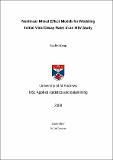Files in this item
Nonlinear mixed effect models for modeling initial viral decay rates in an HIV study
Item metadata
| dc.contributor.advisor | Donovan, Carl | |
| dc.contributor.author | Kang, Sujin | |
| dc.coverage.spatial | 103 p. | en_US |
| dc.date.accessioned | 2020-11-11T09:53:17Z | |
| dc.date.available | 2020-11-11T09:53:17Z | |
| dc.date.issued | 2008-11-27 | |
| dc.identifier.uri | https://hdl.handle.net/10023/20947 | |
| dc.description.abstract | The Nonlinear Mixed Effect Viral Dynamic Model can easily handle unbalanced repeated and continuous measures data for individuals and is also popular in many other research areas such as biology and pharmacokinetics. Wu 𝘦𝘵 𝘢𝘭. (2004) described a Nonlinear Mixed Effects Biphasic Model to estimate short-term population and individual viral decay rates in their study. Perelson 𝘦𝘵 𝘢𝘭. (1999) and Ding 𝘦𝘵 𝘢𝘭. (1999) reported that initial viral decay estimated for viral decay models would be good markers of the potency of antiretroviral regimens. The aim of this study was to model viral decay rates, and check the validity of the model for the set of data provided and investigate whether the relationships found with baseline covariates and long-term response are consistent with Wu 𝘦𝘵 𝘢𝘭.’s (2004) findings. The Nonlinear Mixed Effect Single and Biphasic Viral Dynamic Models were fitted, and their respective initial viral decay rates were derived. In this study, analyses and reports are focused on the first-phase viral decay rates of the models. The study found that the actual treatment groups were more potent than the control group. It was found that actual treatment effect and the number of multi-PI mutations at baseline had impacts on the initial viral decay rates for both models. Besides, baseline HIV-1 RNA levels had an impact on the initial viral decay rates for the biphasic model. There were no significant differences in the initial viral decay rates for different ages, ethnicities, and gender groups. The study also shows that the initial viral decay rates were somewhat negatively correlated with the baseline HIV-1 RNA levels. A strong correlation between the initial viral decay rates and week 1 virus load reduction from baseline was observed. It was also observed that individuals with the higher initial viral decay rates were more likely to have suppressed virus load at week 24. Also, individuals with higher week 1 virus load reduction, i.e. early viral dynamics, were more likely to have suppressed virus load at week 24. These findings suggest that the antiviral potency or the initial viral decay rates are predictive of long-term viral load response. | en_US |
| dc.language.iso | en | en_US |
| dc.subject | HIV | en |
| dc.subject | Initial viral decay rates | en |
| dc.subject | Long-term response | en |
| dc.subject | Nonlinear mixed effect models | en |
| dc.subject | Single and biphasic viral dynamic models | en |
| dc.subject | Actual treatment effect | en |
| dc.subject | Number of multi-PI mutations | en |
| dc.subject | Baseline HIV-1 RNA levels | en |
| dc.title | Nonlinear mixed effect models for modeling initial viral decay rates in an HIV study | en_US |
| dc.type | Thesis | en_US |
| dc.type.qualificationlevel | Masters | en_US |
| dc.type.qualificationname | MSc Master of Science | en_US |
| dc.publisher.institution | The University of St Andrews | en_US |
This item appears in the following Collection(s)
Items in the St Andrews Research Repository are protected by copyright, with all rights reserved, unless otherwise indicated.

